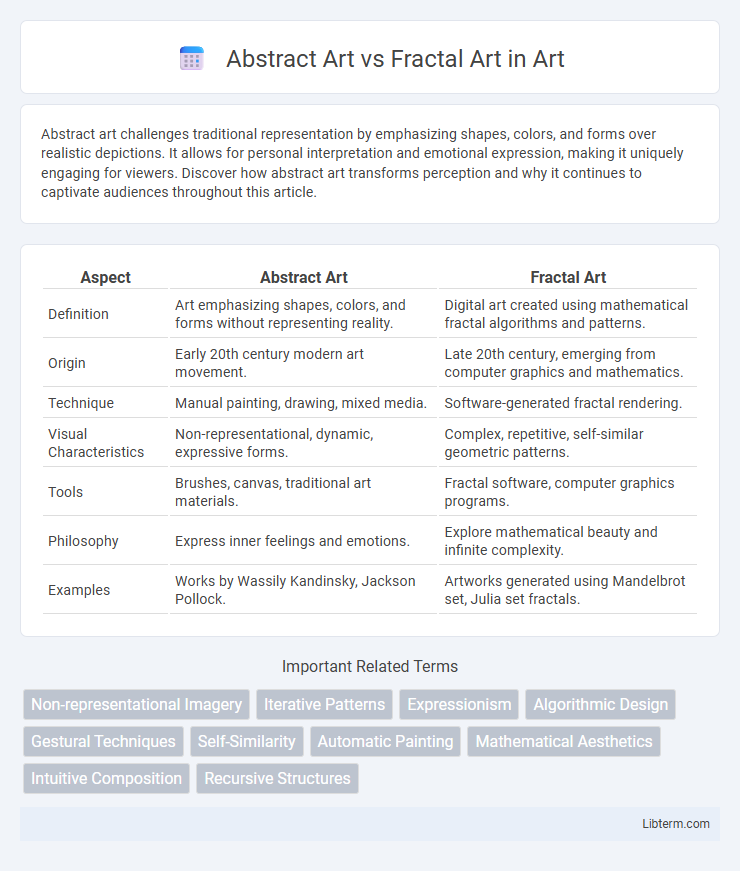Abstract art challenges traditional representation by emphasizing shapes, colors, and forms over realistic depictions. It allows for personal interpretation and emotional expression, making it uniquely engaging for viewers. Discover how abstract art transforms perception and why it continues to captivate audiences throughout this article.
Table of Comparison
| Aspect | Abstract Art | Fractal Art |
|---|---|---|
| Definition | Art emphasizing shapes, colors, and forms without representing reality. | Digital art created using mathematical fractal algorithms and patterns. |
| Origin | Early 20th century modern art movement. | Late 20th century, emerging from computer graphics and mathematics. |
| Technique | Manual painting, drawing, mixed media. | Software-generated fractal rendering. |
| Visual Characteristics | Non-representational, dynamic, expressive forms. | Complex, repetitive, self-similar geometric patterns. |
| Tools | Brushes, canvas, traditional art materials. | Fractal software, computer graphics programs. |
| Philosophy | Express inner feelings and emotions. | Explore mathematical beauty and infinite complexity. |
| Examples | Works by Wassily Kandinsky, Jackson Pollock. | Artworks generated using Mandelbrot set, Julia set fractals. |
Defining Abstract Art: Concepts and History
Abstract art, emerging in the early 20th century, prioritizes shapes, colors, and forms over realistic representation to evoke emotions and ideas. Key artists like Wassily Kandinsky and Piet Mondrian pioneered this movement, emphasizing non-objective compositions and visual language that transcends literal interpretation. This art form influenced various modern art developments by breaking away from traditional artistic conventions and exploring the essence of visual expression.
Understanding Fractal Art: Origins and Techniques
Fractal art originates from mathematical algorithms that generate infinitely complex patterns, often based on recursive formulas and self-similarity principles. Techniques involve using computer software to visualize fractals such as the Mandelbrot set and Julia set, creating intricate, colorful designs that emphasize order within chaos. Unlike traditional abstract art, fractal art combines digital precision with natural complexity, offering a blend of scientific and artistic expression.
Key Visual Differences Between Abstract and Fractal Art
Abstract art emphasizes freeform shapes, bold colors, and expressive brushstrokes that evoke emotions through non-representational forms. Fractal art is characterized by intricate, repetitive patterns generated by mathematical algorithms, creating visually complex and often symmetrical designs. Unlike abstract art's spontaneous creativity, fractal art relies on precise calculations to produce detailed, infinitely scalable images.
Core Philosophies: Expression vs. Algorithm
Abstract art emphasizes human emotion and subjective interpretation, using spontaneous brushstrokes and shapes to convey inner experiences. Fractal art relies on mathematical algorithms and iterative processes, generating complex patterns that mirror nature's inherent order. The core philosophy of abstract art values personal creativity and emotional expression, while fractal art centers on the exploration of structured, algorithm-driven beauty.
Tools and Mediums Used in Abstract and Fractal Art
Abstract art typically utilizes traditional tools such as brushes, palette knives, and various paints including oils, acrylics, and watercolors, applied on canvas or paper to create non-representational forms. Fractal art relies heavily on digital software like Apophysis, Ultra Fractal, and Mandelbulb 3D, enabling artists to generate complex mathematical patterns through algorithms and computer processing. Both mediums embrace experimental techniques, but fractal art is fundamentally dependent on computational tools, contrasting with the tactile, manual methods predominant in abstract art.
Creative Processes: Intuition vs. Mathematics
Abstract art primarily relies on intuition, emotion, and spontaneous expression, allowing artists to explore feelings and ideas through color, shape, and texture without strict rules. Fractal art, in contrast, uses mathematical algorithms and iterative calculations to generate complex, self-similar patterns, emphasizing precision and computational design. The creative process in fractal art merges technology and creativity, while abstract art remains deeply personal and subjective.
Impact on Modern Digital Art Movements
Abstract art influenced modern digital art movements by emphasizing non-representational forms and emotional expression, inspiring artists to explore digital tools for creating visually complex compositions. Fractal art introduced algorithmic precision and mathematical beauty into digital aesthetics, enabling the generation of intricate patterns through computer programming. The fusion of abstract concepts with fractal algorithms has propelled innovation in digital art, shaping generative art, glitch art, and interactive visual experiences.
Cultural and Artistic Influences Shaping Both Styles
Abstract art evolved through early 20th-century movements like Cubism and Surrealism, emphasizing emotional expression and subjective interpretation shaped by modernist cultural shifts. Fractal art originates from mathematical principles and digital technology, reflecting contemporary culture's integration of science and algorithmic creativity. Both styles represent distinct artistic responses to their cultural contexts, with abstract art rooted in human emotion and fractal art in computational aesthetics.
Collectibility and Value in the Contemporary Art Market
Abstract art, characterized by its emotional depth and unique artist expression, maintains strong collectibility due to its historical significance and presence in major galleries. Fractal art, generated through mathematical algorithms and digital processes, is gaining traction in the contemporary art market as a novel, technology-driven medium with growing appeal among digital art collectors and NFT investors. Market value for abstract art remains relatively stable, driven by established artists and provenance, whereas fractal art's value is more volatile but shows increasing potential as digital art platforms and blockchain authentication expand.
Future Trends: Evolving Boundaries in Non-Representational Art
Future trends in abstract and fractal art highlight the fusion of algorithmic processes with traditional artistic techniques, enabling unprecedented complexity and depth in non-representational visuals. Advances in AI-driven generative models and virtual reality platforms are expanding the experiential and interactive dimensions of these art forms. This evolution is reshaping artistic boundaries, fostering new modes of creation that challenge conventional definitions of abstraction and digital aesthetics.
Abstract Art Infographic

 libterm.com
libterm.com